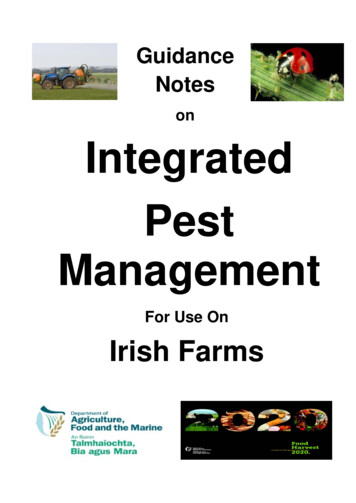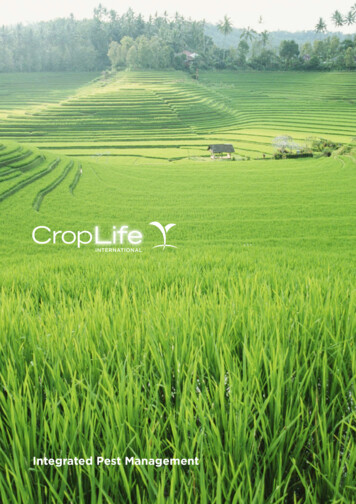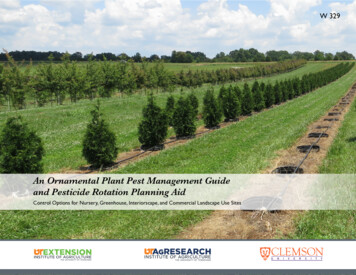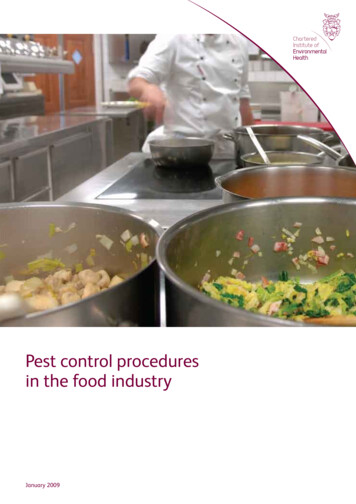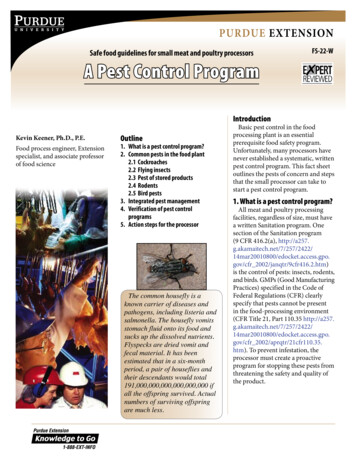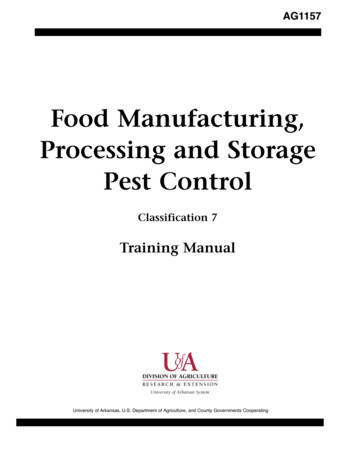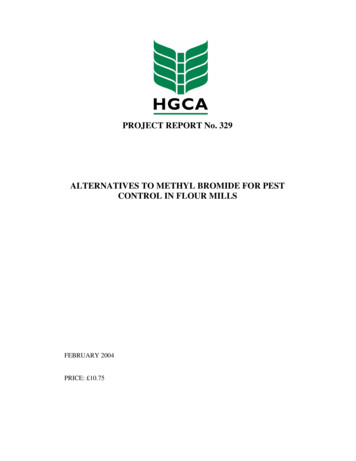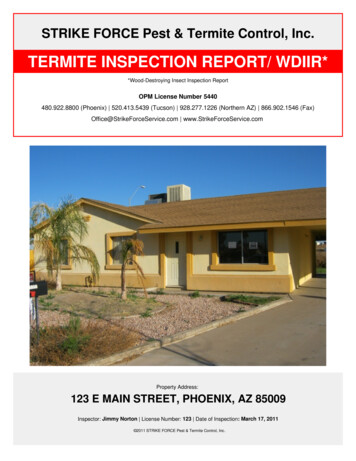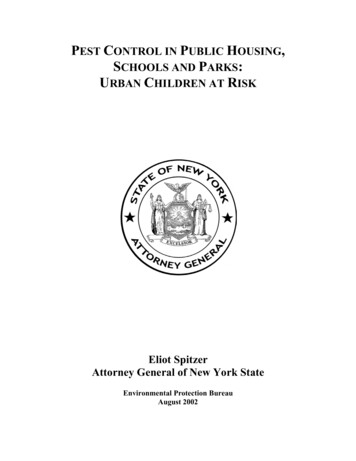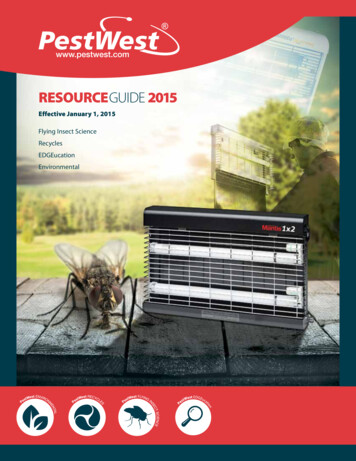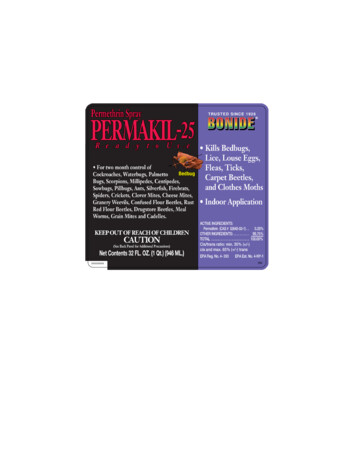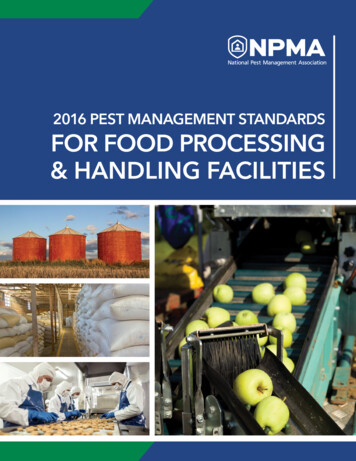
Transcription
2016 PEST MANAGEMENT STANDARDSFOR FOOD PROCESSING& HANDLING FACILITIES
Pest Management Standards for Food Processing & Handling Facilities IntroductionINTRODUCTIONThe National Pest Management Association (NPMA) is pleased to release the2016 Pest Management Standards for Food Processing and Handling Facilities.Since 2007, NPMA guidance on pest management in food facilities has beenthe cornerstone of NPMA’s commercial activities. These standards were lastupdated in 2013 and this 2016 version provides updates and improvementsto better address changing regulatory requirements, new technologies andbetter integrated pest management practices.The publication of this 2016 revision coincides with the implementation ofthe Food Safety Modernization Act (FSMA). FSMA will reform our food safetysystem by ensuring a safe food supply based on prevention rather than reaction.The new FSMA standards will bring increased scrutiny and oversight to the entirefood industry which requires sanitation standards only achievable through properpest management practices.Of note in the 2016 revision the name was changed from Pest ManagementStandards for “Food Plants” to “Processing and Handling Facilities” to betterreflect the intended scope of these standards. Other new additions includeaddressing the use of remote monitoring technology and the addition of a“sample risk assessment” that may be used as a reference to assist in analyzing,creating and maintaining a successful pest management plan. In the 2013revision we moved away from prescriptive instructions regarding placementand monitoring frequency in favor of a results oriented approach based ontrends, inspection and observations. The 2016 revision maintains this approachbut provides some baselines in situations where historical data is unavailable.These standards are general guidance for the industry and require the use ofindependent judgment when implementing a pest management plan in foodprocessing and handling facilities. As stated in previous editions, these standardsdo not preempt local, state, or federal laws and regulations. Any service providedmust comply with relevant statutes and regulations governing pest management,safety and food protection. In addition, food plants may have requirements morestringent than these standards.To demonstrate understanding on these standards, NPMA maintains studymaterials and an online exam at www.npmatesting.com. Upon successfulcompletion, the system generates a completion certificate. Printed study guidesand standards can be purchased from NPMA at www.npmapestworld.org.Through online testing and food safety resources, NPMA is working to providePest Management Standards for Food Processing & Handling Facilitiesi
Pest Management Standards for Food Processing & Handling Facilities Introductionthe tools necessary for pest management firms to comply with the standards and raisethe level of competency of pest management professionals servicing food plants.We hope that you find these standards to be a beneficial resource for your organization.As protectors of food and property and defenders of public health it is our industry’sobligation to exceed expectations and demonstrate the pest management industry’svital role in food safety.ii2016 National Pest Management Association, Inc.
Pest Management Standards for Food Processing &StandardHandlingSectionFacilities3 Table of ContentsTABLE OF CONTENTSSECTION 1.01.11.21.31.41.51.61.71.8PERSONNELEmployee IdentificationUniformsSecurity and Criminal Background ChecksFacility Personnel PracticesVehiclesSafetyMinimum Training Standards for TechniciansCompliance with Food Safety Rules CGMPs1345678910SECTION 2.152.16PEST MANAGEMENT PLANRodent Program — Exterior Property SurveyRodent Program — Interior SurveyRodent Program — Facility HistoryRodent Program — Frequency of ServiceRodent Program — Spacing of Rodent Management DevicesRodent Program — MonitoringRemote Electronic Monitoring TechnologyInsect ProgramBirds and WildlifeWeed ManagementPest Management SurveyStorage — Standard NumberCompliance with Facility Food Allergen Control ProgramQuality AssuranceAnnual TrainingAnnual Review1113141516171920212425262728293031SECTION 3.0 COMMUNICATIONS3.1 Reporting3335SECTION 4.04.14.24.34.44.54.637394041424344RECORDKEEPING AND CONTRACTSContractsLabels and Safety Data SheetsPest Sighting LogLicenses and CertificatesService Protocols and Standard Operating ProceduresService and Treatment RecordsSECTION 5.0 NATIONAL ORGANIC PROGRAM5.1 Working in NOP Facilities4547APPENDIX A PEST MANAGEMENT INSPECTION REPORT49APPENDIX B SAMPLE RISK ASSESSMENT51APPENDIX C CURRENT GOOD MANUFACTURING PRACTICES, 21 C.F.R. §11757Pest Management Standards for Food Processing & Handling Facilitiesiii
Pest Management Standards for Food Processing & Handling Facilities DefinitionsDEFINITIONSFor definition purposes,Action Threshold means level of pest activity or pest damage thattriggers a pest management response.Company means the pest management firmContact means the food facility contact personCurrent Good Manufacturing Practices means the FDA’s Current GoodManufacturing Practices (CGMPs) in the United States, or equivalentoutside of the U.S.Devices any equipment used to monitor or control pests including,but not limited to, insect monitors, rodent bait stations, insect lighttraps, pheromone traps, and rodent management stations.Employee means pest management firm employeeFacility is used interchangeably throughout these standards asthe shortened version for “Food Processing and Handling Facility”Food Processing and Handling Facility means any food facility engagedin food production, manufacturing, storing/warehousing and distribution.This does not include restaurants or other food service facilities.Pest management product means any lure, bait, monitoring product,pesticide, or any other formulated material used in performance ofpest management activities.Rodent bait station means any station used for placement of solidrodenticide baitRodent management device means any device used for monitoring ormanaging rodents. These include mechanical traps, rodent bait stations(see above), and other placed equipment for rodent management.Technician means the pest management firm employee providing serviceWe hope that you find these standards to be a beneficial resource for your organization.As protectors of food and property and defenders of public health it is our industry’sobligation to exceed expectations and demonstrate the pest management industry’svital role in food safety.iv2016 National Pest Management Association, Inc.
SECTION 1PersonnelPest Management Standards for Food Processing & Handling Facilities1
Standard Section 1 Personnel22016 National Pest Management Association, Inc.
Standard Section 1 Personnel1.1EMPLOYEE IDENTIFICATIONBoth food security and safety are the primary concern of the food facility. This sectionsets forth minimum standards for company employee identification so that the facilityhas a clear understanding of which personnel are from the pest management companyto ensure that facility food safety and security are maintained.All employees entering grounds of a food facility shall display photo identification to include: Employee name Employee identification number (if issued by the company) Company name Company phone number Employee photo Date of issueThe identification shall be displayed at all times while the employee is on site unlesspersonnel practices set by the facility prohibit such badges. In addition, facilities mayrequire other identification such as visitor badges or facility issued contractor badges andthe employee must comply at all times with the visitor/contractor policies of the facility.Pest Management Standards for Food Processing & Handling Facilities3
Standard Section 1 Personnel1.2UNIFORMSUniforms are an important part of the facility safety and standards program. Criteria aredesigned to comply with the majority of food facility requirements and CGMPs for uniforms.All employees who perform service work in food facilities shall wear uniformsmeeting current facility requirements and at least the following criteria: Slip resistant sole shoes (safety toe if required by facility) Socks Long pants Shirt with sleeves (short or long) with company logo or company name Uniform closures shall be in compliance with facility requirements.A clean set of clothing shall be used in facilities. If the uniform is exposed to contaminantsa clean set of clothing should be readily available. These contaminants include but arenot limited to chemical, microbiological, or allergens such as peanut products.More stringent requirements may be in place for individual facilities in addition to thesestandards and service personnel must comply with those standards. Some facilities mayrequire the use of designated shoes, shoe covers, smocks and/or lint brushes prior toentering sensitive food processing areas.42016 National Pest Management Association, Inc.
Standard Section 1 Personnel1.3SECURITY AND CRIMINALBACKGROUND CHECKSSecurity is a major concern at all food facilities. This section is designed to ensure thatpersonnel in food facilities have had proper background checks and that they complywith facility rules.Any newly hired employee, including management, entering a food facility shall have acriminal background check performed covering the previous five years prior to the dateof hire. The checks shall be part of the records of the company and shall include all statesor provinces in which the employee has lived and/or worked during the previous five years.Resulting action as a result of the check will be at the discretion of company management.Some food facilities may have specific requirements and companies must comply withthese requirements in addition to the above. Reminder: Companies must comply withgovernment regulations related to obtaining background checks.Facilities may also have policies regarding when an employee is permitted onsite andif they require a facility escort. Companies should understand and comply with all facilitypolicies and provide a written procedure to employees with a copy in the facility regarding: Whether advanced notice mustbe given prior to arrival onsite Visitor badge and/orcontractor badge policies Parking and vehicle use Confidentiality offacility information Notice of new or substituteemployees (technicians takingthe place of previous techniciansmay have to be on a rosterprovided to the facility) Sign-in policies Hours of operation whenemployees may have accessPest Management Standards for Food Processing & Handling Facilities Escort policies Restricted areas Access to locked or restrictedareas via an assigned key,card, fob, access code etc.5
Standard Section 1 Personnel1.4FACILITY PERSONNEL PRACTICESIt is imperative that all employees entering a food facility property understand and complywith facility personnel practices. Besides being required by law, compliance is important aspart of food safety and also facility personnel morale.Where applicable, all employees entering food facility property must have reviewed andsigned off on the standards of the facility in terms of personnel practices as outlined bythe facility. If a special set of standards is in place for facility contractors, then the employeemust comply with the standards. If any questions or conflicts arise, the employee must notifytheir supervisor and the facility contact person.A copy of the signed document shall be made available upon request.62016 National Pest Management Association, Inc.
Standard Section 1 Personnel1.5VEHICLESFacilities may have specific requirements for vehicles both in terms of operationsand in terms of security. This section sets the minimum for vehicle standards.All vehicles used for service must: Be clearly marked with company name Be properly licensed Have a current inspection if required by the state or province. Have adequate insurance coverage for bodily injury, propertydamage and any other coverage that may be required by the facility Be parked in properly assigned area Have materials and equipment secured when unattended to restrict accessA five year motor vehicle background check must be completed for all new companyemployees who will drive on facility property.All drivers must have viewed the NPMA Safe Driving Video or participate in an insuranceindustry approved program annually and the company must retain safe driving trainingrecords as required by the insurance company. In addition, the vehicle must include at least the following equipment: First aid kit Spill control to cover all products on the vehicle Service kit (carrying kit for small quantities of products and equipment) Change of clothing and/or coveralls Other equipment required by facilityPest Management Standards for Food Processing & Handling Facilities7
Standard Section 1 Personnel1.6SAFETYSafety is a vital part of any pest management program. The pest managementcompany and the food facility both must maintain safe working environments.Beyond minimal regulatory requirements, policies must be in place to ensurea safe work environment.Each company must have a documented safety training of all employees workingin food facilities. Safety training should include but is not limited to: Facility-specific safety training The company and facility specificrespiratory protection program Pesticide safety includingthe proper understandingof all labels of products tobe used in the food facility,proper use, and disposal ofproducts and containers Proper storage ofproducts and equipment Emergency responseprocedures in case of spills Safety of other personnel nearpest management activitiessuch as facility employeesand t
INTRODUCTION. The National Pest Management Association (NPMA) is pleased to release the 2016 Pest Management Standards for Food Processing and Handling Facilities. Since 2007, NPMA guidance on pest management in food facilities has been the cornerstone of NPMA’s commercial activities.File Size: 1MBPage Count: 92
